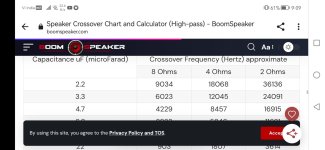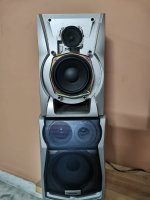It depends. Those are all very high crossover values, so probably #2 will be best if the tweeter can be used down to 5kHz.
@allwnB i am making a bookshelf speaker.
A woofer and tweeter
The plan is to let the woofer handle the full range of frequencies and tweeter will me handling highs.
Any recommendations for achieving the optimal combination based on the above pic ?
By the way woofer is 6 ohms 8inch.
A woofer and tweeter
The plan is to let the woofer handle the full range of frequencies and tweeter will me handling highs.
Any recommendations for achieving the optimal combination based on the above pic ?
By the way woofer is 6 ohms 8inch.
There is 2 sticky threads covering basics in respect to what you would like done, and additionally there is numerous thousands of posts
scattered in multy way forum on topic as well.
scattered in multy way forum on topic as well.
Do you have any recommended apps or websites where I can get accurate tweeter frequencies? I have noticed variations in results across different sources.
There are variations between the various calculators, but they are so small that they are negligible.
For your purposes (high pass filter capacitor only) this calculator will do the job:
https://boomspeaker.com/speaker-crossover-chart-and-calculator-high-pass/
Scroll down to "Calculate for Any Value".
P.S. I have used the 2.2 uF, 8 ohm tweeter combination in the past with good results.
You need to crossover at a high frequency like 9 kHz because the roll-off is shallow, meaning the tweeter will still produce a lot of energy one octave below the crossover frequency, i.e., at 4.5 kHz.
P.S. Your calculation in post #4 is wrong.
f = 1 / (2 x pi x C x Xc)
f = 9043 Hz by my calculator.
You should know by now not to contradict the 'experts'! 😀
f = 1 / (2 x pi x C x Xc)
f = 9043 Hz by my calculator.
You should know by now not to contradict the 'experts'! 😀
Great calculation! Your accuracy is on point, as always. Well done! 😉
P.S. Your calculation in post #4 is wrong.
f = 1 / (2 x pi x C x Xc)
f = 9043 Hz by my calculator.
You should know by now not to contradict the 'experts'! 😀
P.P.S. You now have all the information you need.
I have a quick question regarding my setup 3.3uF and 4 ohms Will this combination be suitable for my purpose, Fc 12045.
4 ohm tweeters are more common and easier to find, whereas 8 ohm ones are a bit rare and harder. If opting for 8 ohms yields better results, I'm willing to make the extra effort to find them.
Appreciate your prompt response once more. Thank you!
Attachments
I would use 4.7 uF with 4 ohms in order to produce similar results to 2.2 uF with 8 ohms.
I say this because I know that the resulting crossover frequency of around 9 kHz works well in a situation such as yours.
HANDY RULE: Half the driver impedance and you must double the capacitance in order to obtain the same crossover frequency.
No need to seek out 8 ohm tweeters, 4 ohm tweeters will sound the same in your application, provided you get the capacitance right!
That's me out - no more questions please!
I say this because I know that the resulting crossover frequency of around 9 kHz works well in a situation such as yours.
HANDY RULE: Half the driver impedance and you must double the capacitance in order to obtain the same crossover frequency.
No need to seek out 8 ohm tweeters, 4 ohm tweeters will sound the same in your application, provided you get the capacitance right!
That's me out - no more questions please!
'Optimal' XO point/slope should be based on matching polar responses.Any recommendations for achieving the optimal combination based on the above pic ?
As GM said, the optimum is the one that will match up with the midrange driver's low pass, polar response, distortion etc., and provide the necessary power-handling / protection from over-excursion etc. for the tweeter. Without that information, or anything that could provide any guidance, you'd probably get about as much useful (i.e. nothing) out of an ouija board.
I believe the speaker in question, temporarily fitted with a 2.5 inch 'full range' speaker as a tweeter, is shown in the attachment.
That is, the 2-way one on top of the stack.
It was originally a Kenwood mass market music system speaker. The original tweeters were blown and the woofer replaced with an Aiwa unit.
Kamranbits can correct me if I am wrong.
That is, the 2-way one on top of the stack.
It was originally a Kenwood mass market music system speaker. The original tweeters were blown and the woofer replaced with an Aiwa unit.
Kamranbits can correct me if I am wrong.
Attachments
- Status
- Not open for further replies.
- Home
- Loudspeakers
- Multi-Way
- Which combination is best


